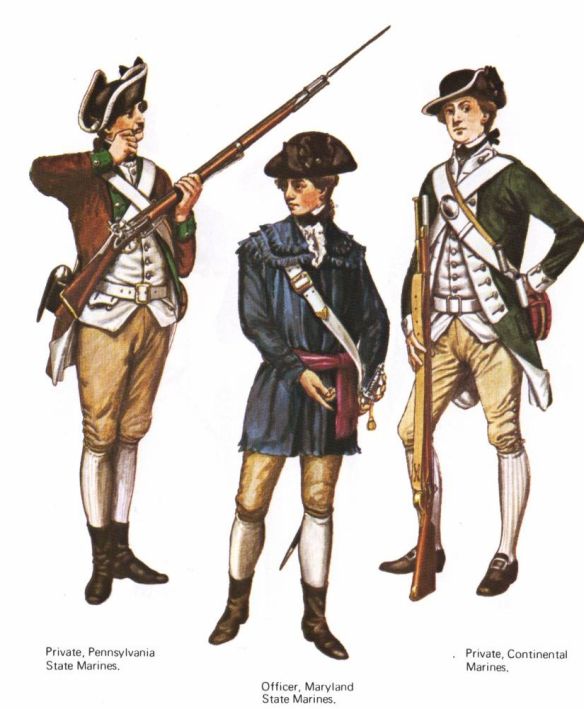On November 10, 1775, the Continental Congress commissioned Robert Mullan, proprietor of the Tun Tavern in Philadelphia, to raise two battalions of marines under the leadership of SAMUEL NICHOLAS . On November 28, Nicholas was formally commissioned captain of the new force, called the Continental Marines, and although never officially appointed as commandant, he assumed that role as a practical matter. Today, the Tun Tavern is still considered the birthplace of the United States Marine Corps.
The Continental Congress authorized two battalions of marines, specifying that those recruited be good seamen, “able to serve to advantage by sea.” Nicholas was soon promoted to major and, in March 1776, under the overall command of the navy’s John Paul Jones, Nicholas led 200 marines (and 50 sailors) in the first marine amphibious assault, landing on New Providence Island in the Bahamas. In a 13-day operation, the marines secured two forts, occupied Nassau, seized control of Government House, and captured 88 guns, 16,535 rounds of ammunition, and other supplies.
Nicholas and the marines next saw action in December 1776, when three companies (80 men) accompanied Washington’s army in the successful Battle of Trenton. The marine companies remained with Washington in winter quarters at Morristown, New Jersey, until February 1777. In the spring, Washington formally incorporated some marines into artillery units of his Continental army, while Nicholas returned to Philadelphia and his shore- based marines were assigned to defensive duty in Delaware.
A small number of marines were deployed to New Orleans in January 1778 to keep British traders out of the port, and in April of that year, 20 marines were attached to service with John Paul Jones to sail on the Ranger, which raided the English coast. The marines participated in two raids, the first on British soil in some seven centuries. A handful of marines also accompanied Jones on the Bon Homme Richard during August 1779.
Continental Marines participated in a valiant but failed attack on Fort George in the Penobscot River in July 1779; they also served escort duty, assigned to guard a caravan of ox carts conveying a million silver crowns, loaned by France, from Boston’s harbor to Philadelphia. In January 1783, Continental Marines formed the boarding party that seized the British ship Baille in the West Indies. This was the last military operation performed by the force.
At the conclusion of the American Revolution, Congress acted swiftly to disband the Continental army and the Continental navy. The Continental Marines was officially dissolved in June 1785, and it was not until July 11, 1798, that President John Adams signed the bill creating its successor organization, the United States Marine Corps.
Act of July 11, 1798
The Act of July 11, 1798, was the first U. S. law organizing a “Corps of Marines” from the U. S. Navy’s marines. It is titled “An Act for Establishing a Marine Corps” and provided for the three-year enlistment of 32 marines as ship guards. A major was to be chosen as COMMANDANT OF THE MARINE CORPS to administer the USMC. Thirty-two captains and lieutenants were authorized (no distinction was made between first lieutenants and second lieutenants). In addition, 48 sergeants and corporals were authorized, along with 720 privates, 32 fifers, and 32 drummers. While serving ashore, the marines would follow the Articles of War, the same regulations that governed the U. S. Army. Embarked at sea, however, the marines were to be governed by navy regulations. The 1798 legislation did not give the Marine Corps an organization or mission independent of the U. S. Navy. It did, however, provide that the president of the United States might use the USMC as he saw fit.
Act of June 30, 1834
The ACT OF JULY 11, 1798, established the USMC as a separate armed service and roughly put marines under the Articles of War when they served ashore but under navy regulations when they served aboard ships at sea. This left the USMC’s role in the defense establishment of the United States rather nebulous. Commandant ARCHIBALD HENDERSON complained that the USMC was effectively isolated, with the army on one side and the navy on the other—and neither friendly to the corps. Henderson and others agitated for a clearer definition and legal establishment of the USMC as a matter of the survival of the Corps. Congress responded with the Act of June 30, 1834, which specifically provided that “the Marine Corps . . . shall at all times be subject to the laws and regulations established for the government of the Navy, except when detached for service with the Army by order of the President.” Not only did this make the USMC’s position and governance clearer, it formalized its relationship to the U. S. Navy. For the next 113 years, until the National Security Act of 1947, the USMC was governed by the 1834 law. Only twice during this period did the president see fit to detach the USMC for service with the army: during the U. S.- MEXICAN WAR and during WORLD W AR I. In WORLD WAR II, the USMC functioned closely in coordination with the navy. By the time of the KOREAN W AR , its role had been definitively redefined, along with the roles of the other services, by the National Defense Act.
